
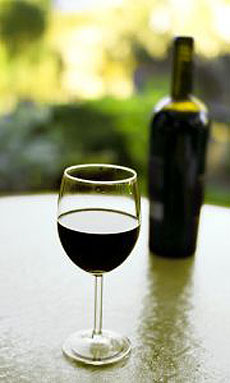 A glass enjoyed at the winery. Photo by Erica Thorpe | SXC.
A glass enjoyed at the winery. Photo by Erica Thorpe | SXC.
|
R. VERONIQUE FITZGERALD is wine consultant and writer in New York City.
|
|
March 2008 |
 |
Product Reviews / Main Nibbles / Wine Brunello di Montalcino:
The Great Red Wine Of Tuscany ~ Part II
CAPSULE REPORT: This is Part II of a two-part article. Part I provides an overview of Brunello’s history and style. Here in Part II, we cover tips on buying recent vintages.
The 2003 Brunello Vintage
According to the Brunello Consorzio’s 2003 Vintage Report, the weather from April to late August was consistently sunny, allowing the grapes to develop well. At harvest, they were exceptionally healthy and high in quality.
Harvest started early, around September 10th. While the heat reduced the quantity of grapes harvested by about 5% of the usual average, it increased the quality of the surviving crop, producing highly concentrated sugars and polyphenols, which contain the antioxidants red wine is so well regarded for. These qualities are early indicators that the wine will likely age well, as polyphenols (tannin is the most recognizable one) behave as preservatives. Just as antioxidants slow aging processes in humans, they do so in wine.
High sugars are an early indicator that the resulting wines will have lots of body. Sugar is what yeast uses to create alcohol during fermentation, and so grapes rich in sugar will produce wines with higher alcohol. This makes for a bigger, more mouth-filling wine. Also, sugar contributes to texture in the mouth, or viscosity.
While many 2003 wines from Europe were uncharacteristically high in alcohol and fruit due to heat waves, Brunello producers at a recent Consorzio tasting in New York said they counted themselves fortunate for their high altitude vineyard land. The temperatures were cooler in higher vineyards, so most winemakers had the acidity, preserved on cool summer nights, to work with.
|
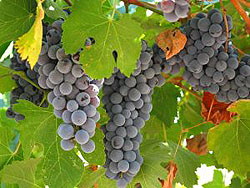
Grapes at harvest. Photo by Chi Le | SXC.
|
Buying Brunello & Rosso
Rosso
One can purchase 2005 and 2006 Rossos at retail for the affordable price of $18.00 to $25.00 per bottle. Some older vintages are still around, but before you think you’re getting a “bottle age bargain,” note that Rossos are meant to be consumed within three years of their vintage. But remember, while these wines are “di Montalcino,” the best grapes were reserved for the Brunello...and the accompanying sticker shock.
Brunello
Thanks in part to the Biondi-Santis and in part to the Consorzio, which has carried the torch for more half a century, Brunello di Montalcino has a distinguished reputation that commands a high price. While there are a few stores that have 750ml bottles for around $25.00, that’s more often the price of a half bottle, with the full size starting closer to the $35.00 mark and heading skyward. A survey of shops in California, Massachusetts and New York show the 2001 Biondi-Santi Brunello di Montalcino for $110.00 to $130.00 per bottle (the Riserva is even more dear), making it one of the most expensive Brunellos at retail.
Truth be told, $35.00 to $60.00 a bottle for a Brunello di Montalcino made by such producers as Altesino, Ciacci (CHA-chi) Piccolomini, Mocali, Pertimali Sassetti, Solaria and Uccelliera (OOH-chel-YEHR-a) is well worth the price for the depth, complexity and longevity of the wine. The wines Brunello producers put on the market in 2001, a vintage rated four stars (excellent) by the Consorzio, will live happily in your cellar for another ten years at least. This is especially true for 2001 Riservas, which will run you more than $60.00 a bottle on the lower end. This is the current vintage, still available nationwide, so scoop them up from your trusted local retailer before they are all gone. The 2003s will supplant the 2001s within a couple of months.
|
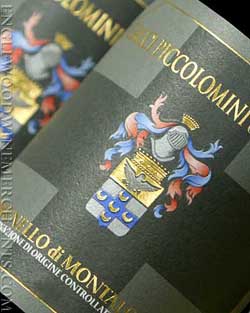
Brunello from Ciacci Piccolomini can be
purchased at EnglewoodWineMerchants.com.
|
Five-Star Brunello Vintages
The most recent vintages that rated an outstanding five stars are 1997 and 1995. The Consorzio gave the 2004 vintage a pre-release rating of five stars, so consumers can look forward to the spring 2009 release. But that’s a year from now, and those wines will still benefit from bottle aging. What can you do today to feed the Brunello bug? Shop America! There are bargains to be had at stores nationwide (especially given the weakness of the dollar, those 2004s won’t come in cheap).
- Wine-Searcher.com shows that some stores in DC, Illinois and Missouri have the 1995s for less than $50.00, bought and priced when the dollar was much stronger.
- The best price we found is $29.99 for a 1995 Mocali Brunello di Montalcino DOCG, at a shop in Chicago. It’s worth the shipping cost!
- A Minneapolis store has a case of 1995 Il Poggione Brunello di Montalcino Riserva DOCG for $729.00, or a very reasonable $60.75 a bottle.
- For the 1997s, a South Egremont, Massachusetts store has a great price of $39.99 for Mocali’s 1997 Brunello, though 1997s can still be found in stores in Florida, New Jersey, New York and Rhode Island.
- A shop in Woburn, Massachusetts has 1997 Collosorbo Brunello di Montalcino Riserva DOCG for $72.79, the best price on Wine-Searcher.com
Tasting Notes
The prices we cite were found on Wine-Searcher.com, a good source for tracking down wines.
2005 Rosso
- Tenuta Silvio Nardi Rosso di Montalcino 2005
This is a fresh, youthful wine with roses, fresh black cherry and tobacco leaf on the nose and berry fruit, with a hint of ginger, on a long palate. It’s a typical Rosso with some depth, still easy drinking and fruit forward. A Fairfield, Connecticut shop lists this wine at $26.99.
2001 Brunello
The 2001 wines were a four-star vintage. They had great structure and balance on release and weren’t always likeable on first go, but they are evolving magically.
 Tenuta Silvio Nardi Brunello di Montalcino DOCG 2001 Tenuta Silvio Nardi Brunello di Montalcino DOCG 2001
Still looks a clear, healthy garnet with fresh red berry fruit and hints of tobacco leaf and tar on the nose. Everything—tannin, acid and alcohol—are big and well-balanced with each other, supporting an otherwise lean, muscular, complex wine with flavors of berries, tea leaf and spice that last through a long finish. Widely available; the best price is $42.00 at Albany, New York and Colorado Springs, Colorado retailers.
At right: Silvio Nardi Brunello.- Tenuta La Fuga Brunello di Montalcino Le Due Sorelle Riserva DOCG 2001
The appearance of aging, marked by the garnet-brick red coloring, is endorsed by secondary characteristics of dark chocolate, cedar, tobacco leaf, dried berries and a hint of licorice on the nose. The palate gives layers of these and other flavors, including tea leaf and clove. A full-bodied wine, it is graceful for its weight, and can be expected to evolve further over another five to seven years. Fantastic! While the chances of finding this particular Riserva are slim (the Brunello DOCG 2001 from this producer is much more available), these characteristics are typical of 2001 Riservas. Wines that have been cared for properly are in great shape today.
2003 Brunello
Although 2003 was also a four-star vintage, the wines are decidedly more simple and precocious, drinking well now and not likely to hold up more than five to seven years after this year’s release. All the prices quoted are pre-arrival quotes. For more notes on the 2003 and 2001 vintages, read Kris Prasad’s selection of top Brunellos.
- Ciacci Piccolomini d’Aragona Brunello di Montalcino DOCG 2003
The wine is still rather youthful, with fresh red berry fruit, coffee and well- balanced acidity on the palate. It is focused and well structured. One should not expect less from this producer, who has consistently wowed the market. This wine will be a fine follow-up for the superb 1999 (vintage rated four stars, excellent) and 2001 vintage. ($47.00 to $60.00) balanced acidity on the palate. It is focused and well structured. One should not expect less from this producer, who has consistently wowed the market. This wine will be a fine follow-up for the superb 1999 (vintage rated four stars, excellent) and 2001 vintage. ($47.00 to $60.00)
- Ciacci Piccolomini d’Aragona Brunello di Montalcino DOCG Pianrosso 2003
This single-vineyard Brunello has leather and earth on the nose, and is big and spicy with high tannin on the palate. It’s a bit on the hot side, though the acidity is definitely intact. The Pianrosso Riserva is super-rare and will run you upwards of $150.00 a bottle for the 2001. A Berkeley, California shop has it for $169.99. ($70.00 to $80.00)
- Mocali Brunello di Montalcino DOCG 2003
This is already showing a bit of age, with some leather and tea leaf notes on the nose. It is round in the mouth and lacking a bit in acidity. The 2001 is a superior wine from this producer. ($50.00)
- Mocali Brunello di Montalcino Vigna Della Raunate Riserva 2003
Fresh red berries on the nose with lovely fruit and well-balanced tannin, acid and alcohol on a lengthy palate. This has the structure to outlive its compatriots up to ten years. (Shown at right—$65.00)
Other Wines Of Montalcino
Moscadello di Montalcino
DOC since 1984, this white wine is made from Moscato Bianco, the same Muscat grape used to make Italian Asti and the Rhône classic, Muscat de Beaumes de Venise. It can be vinified still or sparkling, dry or late harvest.
Sant’Antimo
DOC since 1996, this is a wide denomination that covers both red and white wines that can be made from any or all of the grape varieties permitted in the province of Siena. Allowable grapes include Cabernet Sauvignon, Chardonnay, Merlot, Pinot Grigio, Pinot Nero, Sangiovese Grosso and Sauvignon Blanc. Think of this as an appellation like Napa Valley. A broad variety of grapes are grown in this “controlled origin.”
Brunello producer La Fortuna poured its 2005 Sant’Antimo DOC at the Consorzio tasting. This wine, 60% Cabernet and 40% Sangiovese Grosso, has fresh currants on the nose with some leather and spice, and delivers lots of flavor with layers of baked berries, spice and smoke. One is most likely to find this Sant’Antimo on the wine list at a fine Italian restaurant for $75.00 to $90.00 a bottle—well worth it!
Vin Santo and Novello
Vin Santo is a sweet white wine made Tuscany-wide, from Canaiolo, Malvasia and 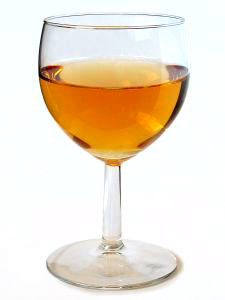 Trebbiano grapes. The grapes are hung or laid out on mats to dry and concentrate their sugars; the wine is aged for long periods in oak or chestnut barrels. A typical dessert is biscotti with a glass of Vin Santo. Trebbiano grapes. The grapes are hung or laid out on mats to dry and concentrate their sugars; the wine is aged for long periods in oak or chestnut barrels. A typical dessert is biscotti with a glass of Vin Santo.
Photo of Vin Santo by Davide Guglielmo | SXC.
Novello is Italy’s answer to Nouveau, as in Beaujolais Nouveau. A simple wine that is released mere weeks after harvest, production and bottling, and originally meant for local consumption, it became an international phenomenon in the 1970s thanks to the marketing genius of Georges DuBoeuf, a French négociant.
Tuscan Cuisine: Dine like the Montalcinesi
In keeping with the Italian tradition of polyculture, honey, olives, and thus, extra virgin olive oil, are other significant products of Montalcino. Indeed, no piece of arable land was relegated to a sole crop The sight of grape vines trellising up the trunks of olive trees was once a common one. The forest and countryside surrounding Montalcino are abundant with wild game, including tasty boar, deer, hare and pheasant, plus fox, gray wolf and many more of nature’s creatures.
So what’s for dinner with all that Rosso and Brunello, Moscadello and Sant’Antimo?
Appetizers
Traditional Tuscan appetizers include marinated cannellini beans (also known as white 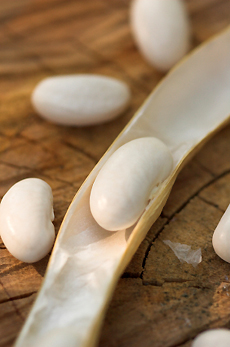 kidney beans) and Pepperoni Arrotolati, rolled red or yellow bell peppers that can be stuffed with a variety of fillings, from a mix of raisins, pine nuts and anchovies to ground meat, mortadella, cooked ham, both adding breadcrumbs to the mix. Or, make a Tomato Bruschetta, with diced tomato, garlic and basil on small slices of olive oil-brushed, toasted bread. (The Sienese claim this latter dish as their own.) The little seasoned toasts can also be topped with paté. kidney beans) and Pepperoni Arrotolati, rolled red or yellow bell peppers that can be stuffed with a variety of fillings, from a mix of raisins, pine nuts and anchovies to ground meat, mortadella, cooked ham, both adding breadcrumbs to the mix. Or, make a Tomato Bruschetta, with diced tomato, garlic and basil on small slices of olive oil-brushed, toasted bread. (The Sienese claim this latter dish as their own.) The little seasoned toasts can also be topped with paté.
Photo of cannellini beans by Tanya Shkondina | IST.
In fact, Tuscans often start their traditional Christmas dinner with Crostini di Fegato, or chicken liver paté on crostini. (Ergo, chopped chicken liver on a cracker was not invented in New York City delicatessens—and perhaps you should be drinking a better wine with that chopped liver.) The Sienese version is Crostini Neri, a paté made with chicken livers and other organ meats (or beef), plus anchovies, capers and onion, cooked in white wine and broth.
These appetizers all call for a fruity, easy drinking Rosso.
First & Main Courses
The closest city that has a culinary influence is Sienna—with Florence not far away. Italians enjoy pasta as a primo piatto, or first course, and pasta with game is very popular. Enjoy an aged Brunello, 2001 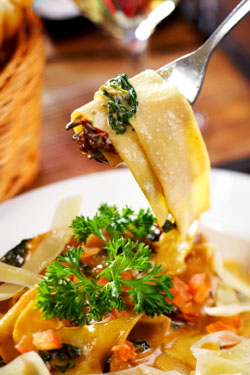 vintage or older, with an earthy Pappardelle con la Lepre (wide ribbons of pasta with rabbit—see our Pasta Glossary for the many types of pasta). vintage or older, with an earthy Pappardelle con la Lepre (wide ribbons of pasta with rabbit—see our Pasta Glossary for the many types of pasta).
Pappardelle are the widest ribbons of pasta except for lasagne. Photo by A. Shyman | IST.
Continue pouring that same wine with your secondo piatto, or second course. Aristà di Maiale is a Sienese classic—pork loin roasted with rosemary, garlic and wild fennel seeds. A similar dish, Aristà di Maiale alla Fiorentina, seasons the tenderloin with thyme, rosemary, garlic, coriander and juniper berries.
For dessert, Siena’s answer to Milan’s panettone is panforte, a dense cake of almonds and candied fruit, sweetened with honey and flavored with spices. Panforte’s roots go back to 12th century Siena. Enjoy a slice with a glass of Vin Santo. A Woburn, Massachusetts shop has a 1985 Pertimali Montalcino Vin Santo, $56.65 for 750ml bottle. That’s enough wine to order a panforte from Sophia’s Sweets and invite friends over for dessert!
While wines ideally pair with their local cuisines (the cuisines were developed over time to match the wines), a Brunello or Riserva can be enjoyed with a good cut of steak, lamb or a fine pork roast. A Rosso will complement a roast chicken. Connoisseurs of fine wine are perfectly happy enjoying it with simple food, allowing the wine to be the highlight of the meal.
Lifestyle Direct, Inc. All rights reserved. Images are the copyright of their respective owners.

|
|







 Tenuta Silvio Nardi Brunello di Montalcino DOCG 2001
Tenuta Silvio Nardi Brunello di Montalcino DOCG 2001 balanced acidity on the palate. It is focused and well structured. One should not expect less from this producer, who has consistently wowed the market. This wine will be a fine follow-up for the superb 1999 (vintage rated four stars, excellent) and 2001 vintage. ($47.00 to $60.00)
balanced acidity on the palate. It is focused and well structured. One should not expect less from this producer, who has consistently wowed the market. This wine will be a fine follow-up for the superb 1999 (vintage rated four stars, excellent) and 2001 vintage. ($47.00 to $60.00) Trebbiano grapes. The grapes are hung or laid out on mats to dry and concentrate their sugars; the wine is aged for long periods in oak or chestnut barrels. A typical dessert is biscotti with a glass of Vin Santo.
Trebbiano grapes. The grapes are hung or laid out on mats to dry and concentrate their sugars; the wine is aged for long periods in oak or chestnut barrels. A typical dessert is biscotti with a glass of Vin Santo.  kidney beans) and Pepperoni Arrotolati, rolled red or yellow bell peppers that can be stuffed with a variety of fillings, from a mix of raisins, pine nuts and anchovies to ground meat, mortadella, cooked ham, both adding breadcrumbs to the mix. Or, make a Tomato Bruschetta, with diced tomato, garlic and basil on small slices of olive oil-brushed, toasted bread. (The Sienese claim this latter dish as their own.) The little seasoned toasts can also be topped with paté.
kidney beans) and Pepperoni Arrotolati, rolled red or yellow bell peppers that can be stuffed with a variety of fillings, from a mix of raisins, pine nuts and anchovies to ground meat, mortadella, cooked ham, both adding breadcrumbs to the mix. Or, make a Tomato Bruschetta, with diced tomato, garlic and basil on small slices of olive oil-brushed, toasted bread. (The Sienese claim this latter dish as their own.) The little seasoned toasts can also be topped with paté.  vintage or older, with an earthy Pappardelle con la Lepre (wide ribbons of pasta with rabbit—see our
vintage or older, with an earthy Pappardelle con la Lepre (wide ribbons of pasta with rabbit—see our